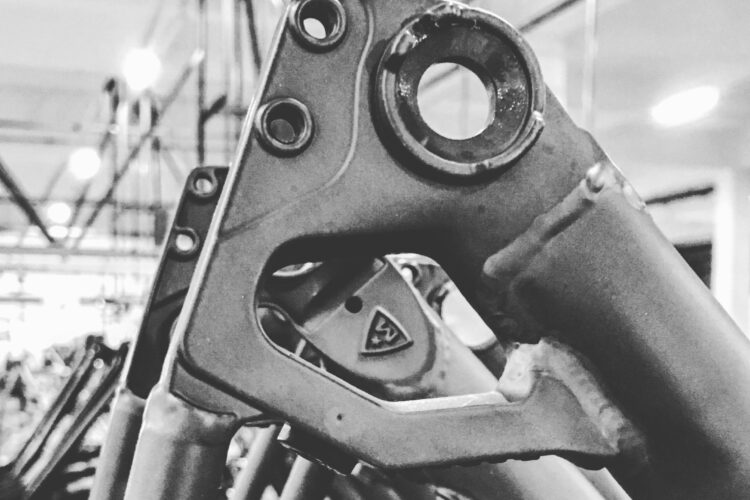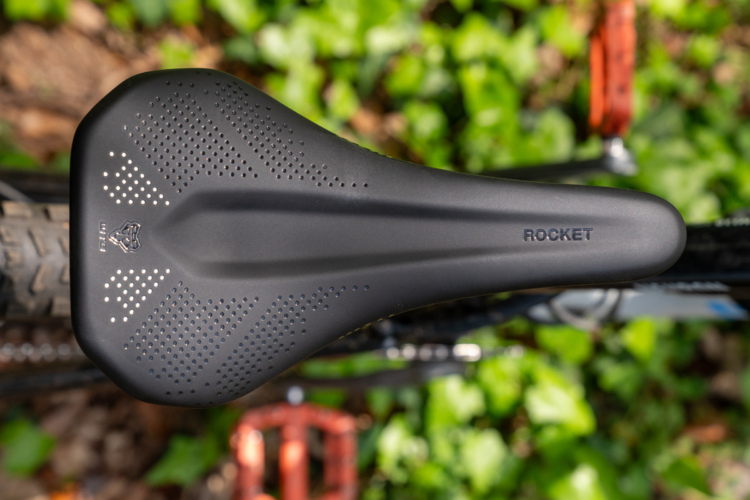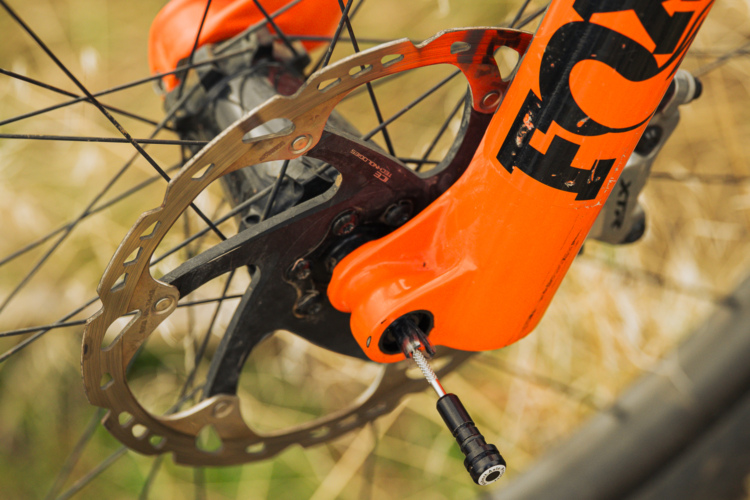
As a mountain bike product tester, I’ve been able to ride some phenomenal bikes and components and some that performed poorly. And during all this time, there has been one upgrade that I felt significantly changed how I ride — a quality wheelset.
And many of you agree with me. At the beginning of April, a Singletracks survey asked which major mountain bike upgrade was the best value. While brakes, drivetrain, suspension, and wheels all received top votes, wheels led the way, landing 29% of the votes.
There is, however, a caveat to a wheelset being the best upgrade, and it pertains to what bike you are upgrading. For example, my wife’s first bike was a Giant Talon. It was the perfect bike for her at the time, since all she wanted it for was to ride up a fire road with our kids. This bike didn’t even have a dropper post, which would have made descending quite a bit easier for her. Getting a new wheelset for that bike would have been silly, and she would never have noticed the difference in performance.
But, if your bike build is between entry-level to intermediate, and you are thinking about upgrading, you’re probably considering four key upgrades: suspension, drivetrain, brakes, and/or wheels. And I stand by my statement — wheels are the way to go. Before I explain why, I’ll tell you why I think the others aren’t as important.

Suspension
Suspension is a usual suspect when it comes to toying with upgrades. On my wife’s Giant Talon I mentioned earlier, the fork was very budget, offering little in the way of adjustments. Upgrading the fork would have made the bike perform better overall but would cost nearly the same as the bike itself, and, at that point, we considered a new bike.
The suspension upgrade I hear people discussing on forums and at trailheads is the upgrade that I don’t feel makes a significant difference. Many bikes will come spec’d with OEM forks, such as the Rhythm series of forks from Fox. These forks lack the significant adjustability on Fox’s aftermarket suspension, such as high and low-speed adjustments for rebound and compression.
There can also be a stigma with OEM components. I read one forum thread where the author asked about upgrading from a Fox 36 Rhythm, citing poor performance from OEM suspension. He threw out several fork options for an upgrade, asking forum readers their opinion. One option was the Marzocchi Z1—essentially the same fork as the Fox 36 Rhythm, and, as you can imagine, commenters enjoyed pointing that out.
I’m not saying that a Fox 36 Rhythm is “just as good” as a Performance Elite or Fox Factory fork, and if given the option, I would opt for the latter. However, I think many perceive OEM forks, like the 36 Rhythm, as poorly performing because they are OEM or have fewer adjustments.
However, all the adjustments that come with high-level suspension can be overwhelming for the average trail rider. In my experience, I don’t notice a significant performance difference between the Fox 36 Rhythm forks that I’ve ridden and the Fox 36 Performance Elite or even 36 Factory forks. Yes, the Kashima coating looks cool, but it didn’t make me a better rider.
For the average trail rider, adjustable rebound and compression like that of the Fox Rhthym will be enough for the trails they ride. Frankly, adding more adjustments to the suspension only complicates the setup process. Plus, high-speed/low-speed adjustability may not be necessary for most riders on most trails.
If a fork like a Fox 36 Rhythm is performing poorly, there can be many things causing the issue that should first be addressed. What many people may assume is poor-performing OEM suspension can actually be poorly set up suspension. Instead of running out and upgrading to the most adjustable suspension, consider having a professional set up your current suspension.

Brakes
Honestly, it is hard not to choose brakes as the most significant upgrade. Brakes are a component where bike companies can easily cut corners, saving a buck or two. Especially on entry-level bikes or just a step above, the brakes can leave you wanting more.
But, with that said, there are so many ways to make spec brakes perform better without doing a complete brake upgrade and swap.
Depending on your riding style and terrain, switching from the organic resin pads that come stock in many brakes to a metallic pad can make a huge difference. While having excellent initial bite, resin pads tend to fade quicker, making longer descents more challenging. Metallic pads will have a more consistent bite and won’t fade like resin pads, with the only trade-off being the noise from metallic pads.
Along with switching to metallic pads, getting larger rotors for your bike will also make a significant difference. Larger rotors dissipate heat better, allowing the brakes to last longer.
And finally, making sure the brakes are properly bled can be a night and day difference because even a little air in the lines can mess up their performance.
Simply put, there are many little things you can do to make your current brakes perform better. While testing bikes, I’ve had the opportunity to ride incredibly powerful brakes and brakes that weren’t so powerful. However, as long as they were 4-piston calipers, I found that I could always get quite a bit more power out of a lower-spec brake by doing what I mentioned above.

Drivetrain
Despite having an eight-speed drivetrain, one of my first bikes — a dirt jump/freeride hardtail in the early 2000s — essentially acted as a singlespeed. A few harsh landings mixed with a crash or two, and the derailleur no longer shifted. As a result, I would get the bike in the highest gear possible, focusing on the downhill aspects of my early mountain biking days.
Thankfully, we have come a long way from when my derailleur would only last a few rides. Across the board, drivetrains are built to withstand more abuse, even the “cheaper” ones. Plus, we’ve seen many higher-level drivetrain options trickle down over the years into the budget ones, with 12 speeds essentially becoming standard.
Aside from some weight savings and a feature here or there — such as shifting multiple gears at once — a drivetrain upgrade may not give you the increased performance you may be expecting. Unless you upgrade to an electronic drivetrain, which is a whole different article, there aren’t significant performance increases from one drivetrain to the next. For example, the shifting performance difference between a Shimano SLX and an XT drivetrain is negligible at best but could be completely unnoticeable.
I don’t think I would notice the difference between a Deore 12-speed and an XT drivetrain. Keeping your drivetrain clean, lubed, and tuned goes a long way in having a drivetrain perform well and, in many cases, makes an upgrade unnecessary.

Why wheelsets are the #1 upgrade
There are several things to make brakes perform better, and keeping drivetrains lubed and clean will allow them to run like new. For suspension, “poor performance” is often due to a poor setup.
Regarding the performance of your wheels, there are far fewer options to increase performance other than a tubeless conversion. When considering wheels that perform better, we are usually talking about a higher-engaging hub paired with a stiffer rim.
Specifically, in most cases, we want the rim to be laterally stiff but vertically compliant. Lateral stiffness means the wheel will better hold lines in corners, while vertical compliance has the wheel absorbing impacts encountered on the trail.
If you upgrade from the OEM wheelset that comes on many entry- to mid-level bikes, this is a difference you will absolutely notice. And, in many cases, it will have you riding faster down the trail, especially in corners. This was my experience the first time I upgraded to a different wheelset.
I found that I could push the bike much harder in the corners, staying off the brakes more than I had previously with my OEM wheels. I thought the instability I felt cornering had been the combination of too much speed and a loose corner when, in reality, I actually felt the flex of my cheap OEM wheels.
With the confidence that a much stiffer wheelset brings, I could push into the corners and ride them significantly faster. Honestly, it is something that I would never have noticed unless I had upgraded the wheels. I thought I was riding corners fast and finding my limit, as well as the limit of the corner. In reality, I was finding the limit of the wheel.
A high-engaging hub is also a significant improvement. Going from 18 points of engagement (POE) on my OEM hub to 90 POE on the Industry Nine 1/1 hub was a significantly noticeable change. Any time I needed to get on the pedals — fast or slow, up or down — the hub engaged.
Upgrading to super-high engaging hubs, like the Industry Nine Hydra, may not be necessary. The difference between 18 POE and 90 POE is drastic, but above 90 POE, the change isn’t that stark.
A stiff rim with a high-engaging hub will be noticeable on the trail. With the other upgrades, you might be fooling yourself. But what about you? What do you think is the most significant component upgrade?





















14 Comments
Jun 15, 2024
Jun 18, 2024
Jun 14, 2024
Also, high POE hubs are a mistake unless you like pedal kickback. I think DT Swiss gets it right with 36.
Jun 12, 2024
Jun 13, 2024
Jun 12, 2024
Jun 13, 2024
Jun 13, 2024
Jun 11, 2024
Jun 12, 2024
Wider rims, i45's with single ply 27.5 x 3.0's, a trialsy frame design. I'm good to go. No bull in a chiner shoppe need apply! Coming from an extensive trials background, I manage just fine tyvm! 12-15 psi and never, evar more. Why? I hate tungsten tires!!
Jun 11, 2024
Wheel upgrades can still be worthwhile, although the author missed one of the top reasons, which is the quality of the bearings and reduced friction thereof, but vertical compliance is not possible unless you are running tireless.
Jun 12, 2024
Jun 11, 2024
Jun 11, 2024